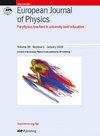Physics language and language use in physics--What do we know and how AI might enhance language-related research and instruction
IF 0.8
4区 教育学
Q4 EDUCATION, SCIENTIFIC DISCIPLINES
引用次数: 0
Abstract
Language is an important resource for physicists and learners of physics to construe physical phenomena and processes, and communicate ideas. Moreover, any physics-related instructional setting is inherently language-bound, and physics literacy is fundamentally related to comprehending and producing both physics-specific and general language. Consequently, characterizing physics language and understanding language use in physics are important goals for research on physics learning and instructional design. Qualitative physics education research offers a variety of insights into the characteristics of language and language use in physics such as the differences between everyday language and scientific language, or metaphors used to convey concepts. However, qualitative language analysis fails to capture distributional (i.e., quantitative) aspects of language use and is resource-intensive to apply in practice. Integrating quantitative and qualitative language analysis in physics education research might be enhanced by recently advanced artificial intelligence-based technologies such as large language models, as these models were found to be capable to systematically process and analyse language data. Large language models offer new potentials in some language-related tasks in physics education research and instruction, yet they are constrained in various ways. In this scoping review, we seek to demonstrate the multifaceted nature of language and language use in physics and answer the question what potentials and limitations artificial intelligence-based methods such as large language models can have in physics education research and instruction on language and language use.物理语言和物理语言的使用--我们知道什么,以及人工智能如何促进语言相关研究和教学
语言是物理学家和物理学习者解释物理现象和过程以及交流思想的重要资源。此外,任何与物理有关的教学环境本质上都与语言有关,而物理素养从根本上说与理解和创造物理专用语言和通用语言有关。因此,描述物理语言的特征和理解物理语言的使用是物理学习和教学设计研究的重要目标。定性物理教育研究为物理语言和语言使用的特点提供了各种见解,如日常用语和科学语言之间的差异,或用来表达概念的隐喻。然而,定性语言分析无法捕捉语言使用的分布(即定量)方面,而且在实际应用中需要耗费大量资源。将定量和定性语言分析整合到物理教育研究中,可能会通过最近先进的基于人工智能的技术(如大型语言模型)得到加强,因为这些模型能够系统地处理和分析语言数据。大型语言模型为物理教育研究和教学中一些与语言相关的任务提供了新的潜力,但它们也受到各种限制。在这篇范围综述中,我们试图展示物理学中语言和语言使用的多面性,并回答在物理教育研究和教学中,基于人工智能的方法(如大型语言模型)在语言和语言使用方面有哪些潜力和局限性。
本文章由计算机程序翻译,如有差异,请以英文原文为准。
求助全文
约1分钟内获得全文
求助全文
来源期刊

European Journal of Physics
物理-物理:综合
CiteScore
1.70
自引率
28.60%
发文量
128
审稿时长
3-8 weeks
期刊介绍:
European Journal of Physics is a journal of the European Physical Society and its primary mission is to assist in maintaining and improving the standard of taught physics in universities and other institutes of higher education.
Authors submitting articles must indicate the usefulness of their material to physics education and make clear the level of readership (undergraduate or graduate) for which the article is intended. Submissions that omit this information or which, in the publisher''s opinion, do not contribute to the above mission will not be considered for publication.
To this end, we welcome articles that provide original insights and aim to enhance learning in one or more areas of physics. They should normally include at least one of the following:
Explanations of how contemporary research can inform the understanding of physics at university level: for example, a survey of a research field at a level accessible to students, explaining how it illustrates some general principles.
Original insights into the derivation of results. These should be of some general interest, consisting of more than corrections to textbooks.
Descriptions of novel laboratory exercises illustrating new techniques of general interest. Those based on relatively inexpensive equipment are especially welcome.
Articles of a scholarly or reflective nature that are aimed to be of interest to, and at a level appropriate for, physics students or recent graduates.
Descriptions of successful and original student projects, experimental, theoretical or computational.
Discussions of the history, philosophy and epistemology of physics, at a level accessible to physics students and teachers.
Reports of new developments in physics curricula and the techniques for teaching physics.
Physics Education Research reports: articles that provide original experimental and/or theoretical research contributions that directly relate to the teaching and learning of university-level physics.
 求助内容:
求助内容: 应助结果提醒方式:
应助结果提醒方式:


